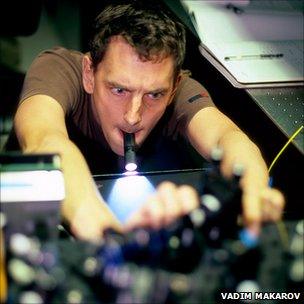Tricking the perfect code machine
- Published

They don't often pose for goofy photographs - the members of the Quantum Hacking group at the Norwegian University of Science and Technology (NTNU), and the Centre for Quantum Technologies at the National University of Singapore.
But everyone wants their picture taken with Eve.
Lurking in the background, she is the one who is not smiling. She also happens to resemble a suitcase full of discarded electronic components - wires, lasers and circuit boards.
But looks can be deceptive. 'Eve' is code-breaking parlance for 'eavesdropper' - and this latter-day Mata Hari might just be the ultimate spy.
The researchers have used Eve to crack a type of coded communication thought to have been impossible to break, called quantum key distribution (QKD).

Eve looks like a pile of components in a suitcase, but she has challenged the cryptography industry
QKD is not an encryption algorithm itself, but a means of securely sharing the cryptographic keys used by sender and recipient to encrypt and decrypt messages.
These pre-agreed ciphers are frequently handed out over fibre optic connections, but being digital files, they could theoretically be intercepted and copied on the way.
"There are ways of exchanging messages that have been proven by mathematics to be highly secure. But they all make one assumption - that you can establish secret keys securely in the first place," said Dr Nick Papanikolaou, security researcher in the Cloud and Security Lab at Hewlett-Packard Laboratories, Bristol.
QKD exploits a key principle in quantum physics - namely that you can't measure or examine individual photons of light without altering their state.
"Once you touch the photon to find out what's going on, you've destroyed whatever information was in there," said Dr Mark Tame, a quantum information researcher at Imperial College London.
When a user wants to exchange a secret key using QKD, they first send a message in specially coded photons to the other user. If an eavesdropper tries to intercept this, they destroy some information - and the communicators know someone is monitoring their communication.
The technique is so effective that it has attracted substantial investment from e-business, banking and defence.
Yet the NTNU team managed to overcome it. So did they defy quantum mechanics?
Trickery

Researcher Ilja Gerhardt tuning an entangled photon-pair source
"We didn't break the laws of physics, or else someone would be getting the Nobel Prize!" laughed NTNU researcher, Dr Vadim Makarov.
Rather than reinventing science, Eve simply tricks the system.
She sits between sender and receiver and intercepts the key, something that would normally be detected.
However, Eve dazzles the receiver's detector with a laser so it can't see individual photons. This allows her to send a faked copy of the photon message.
"We just use bright light. And the detectors do the same thing our eyes do - they're blinded," said Dr Makarov.
However, the sensors remain responsive to strong light. "If we now send a bright flash at them, they think they're seeing a single photon," said Dr Makarov. Eve uses these flashes to duplicate the photon message to the unsuspecting receiver.
The research has sparked debate among scientists. Dr Zhiliang Yuan, a QKD expert at Toshiba Research in Cambridge, believes the blinding attack merely exploits errors in equipment, not in quantum key distribution.
"If you set the detector correctly, it won't be blinded at all," he said.
Quick fix?
Toshiba has since demonstrated how to repel the blinding attack, and QKD manufacturers have incorporated the improved design into their machines.
Yet Dr Makarov thinks that Toshiba's update ignores wider vulnerabilities. "They made a fix which makes our crack ineffective. But there are other methods that can control detectors, even when patched," he said.
So can quantum mechanics ever deliver the ultimate in cryptography - a totally secure system?

The single-photon detector was tricked by blinding it with a laser.
Dr Papanikolaou doubts it. "I'm sceptical about whether we'll be able to build a perfect cryptographic system. We can make them stronger and stronger, improving their tolerance to error. But perfection is just a dream."
Despite this, commercial QKD manufacturers - like Swiss firm ID Quantique - claim to 'redefine security' with their expensive products. How do they react when researchers like Dr Makarov tip them off about new problems, and force hasty improvements to their designs?
"My colleague at ID Quantique says he doesn't know whether I'm his worst friend or his best enemy," laughed Dr Makarov.
- Published5 October 2010